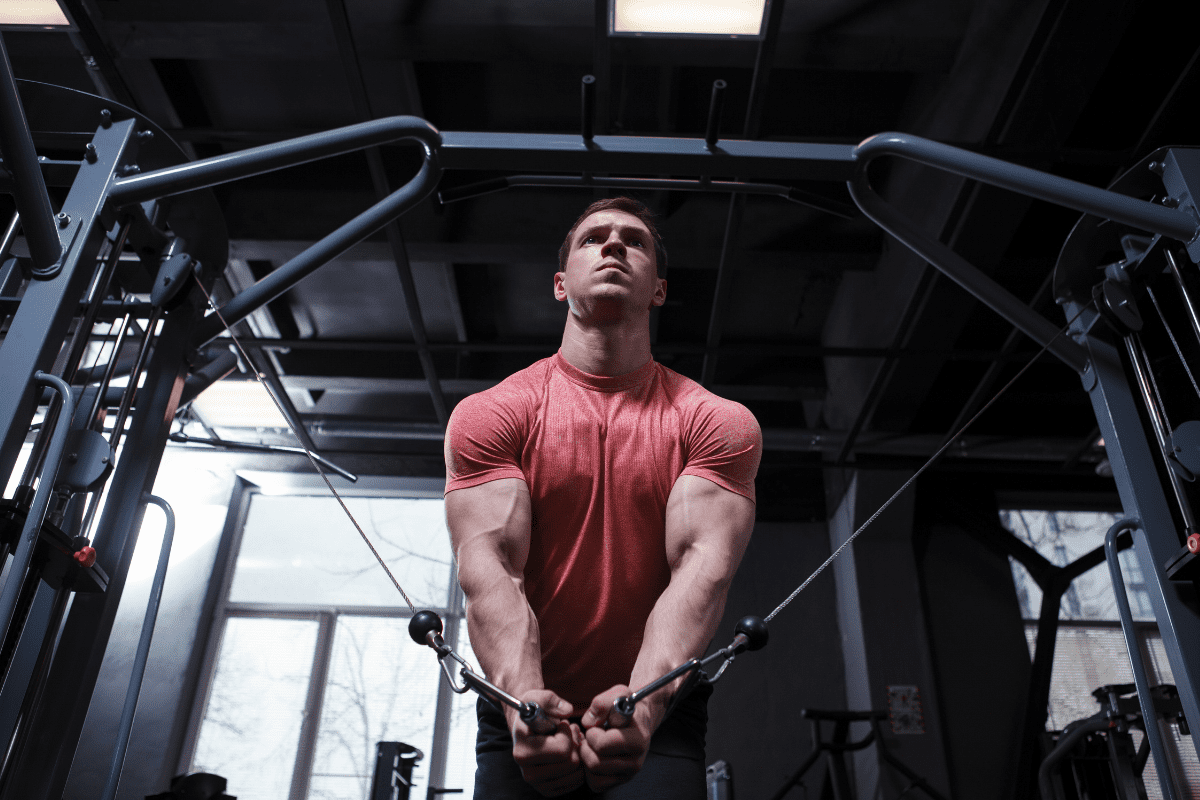11 Best Cable Crossover Alternatives For Chest Day
The Cable Crossover is an extremely popular chest exercise. Almost every commercial gym in the country has a giant dual-tower cable machine. Why do they have this machine that takes up an insane amount of space?
Cable Crossovers.
However, sometimes you may find yourself needing an alternative for Cable Crossovers.
The most obvious reason being you don’t have access to a cable crossover machine. I know I definitely don’t have one in my garage gym.
Whatever the reason, if you’re looking for chest exercises to substitute for Cable Crossovers then you’re in the right place. I’m about to share with you 10 of my favorite Cable Crossover alternatives.
Alternatives for Cable Crossover
I’ve tried to include as much variety in this list of alternatives as possible. There are exercises that utilize all kinds of different equipment – barbell, dumbbells and one that doesn’t really require any equipment at all.
Some closely mimic Cable Crossovers, but not every exercise necessarily does. What all these exercises do have in common, though, is that they all target the chest.
Dumbbell Flys

The closest alternative to Cable Crossovers is Dumbbell Flys. Both movements target the chest in the exact same way. If you have dumbbells, Flys would be my first suggestion.
Equipment Needed
- Dumbbells
- Bench
Step-by-Step Instruction
- Grab your dumbbells, sit on the edge of the bench, and sit the dumbbells on your thighs vertically.
- Take a deep breath, lie flat on your back on the bench, and get your dumbbells in position ready to press.
- Keep your feet flat on the floor and your butt on the bench.
- Pull your shoulder blades together and keep the back of your head on the bench. You will slightly arch your back. Keep your core tight and keep the shoulder blades pulled back tight.
- Press the dumbbells up.
- Now, keep a slight bend in the elbow and lower the dumbbells down until they’re at shoulder height.
- Finally, flex the chest and pull the dumbbells together, back to arm’s length over the chest.
- When your set is done, do not freely drop the dumbbells without checking your surroundings. You could drop the dumbbell and it might hit a person nearby. Or your could drop your dumbbell and crush your fingers on a dumbbell that was left next to your bench.
Coaching Points
Flys should not be done with heavy weights. Stay relatively light, keep the movement very controlled and focus on the stretch.
Remember to finish your sets with awareness so that you and your training partner/fellow gym members stay safe and injury-free. The best way to finish a set is to bring the dumbbells back to your thighs and stand up with them. Or have a lifting partner take them from you.
Incline Dumbbell Fly

Just as a Cable Crossover can be easily adjusted to change the angle of the movement, so can Dumbbell Flys. By simply adjusting the bench up and switching to Incline Dumbbell Flys you can easily add some variety to your chest routine.
Equipment Needed
- Dumbbells
- Adjustable Bench (Capable of changing angles)
Step-by-Step Instruction
- Determine the angle for your incline bench. Most programs would refer to a 45-degree angle as ideal for it provides the best chest and shoulder engagement.
- Grab your dumbbells, sit on the edge of the bench, and sit the dumbbells on your thighs vertically.
- Take a deep breath, lie flat on your back on the bench, and get your dumbbells in position ready to press.
- Keep your feet flat on the floor and your butt on the bench.
- Pull your shoulder blades together and keep the back of your head on the bench. You will slightly arch your back. Keep your core tight and keep the shoulder blades pulled back tight.
- Press the dumbbells up.
- Now, keep a slight bend in the elbow and lower the dumbbells down until they’re at shoulder height.
- Finally, flex the chest and pull the dumbbells together, back to arm’s length over the chest.
- When your set is done, do not freely drop the dumbbells without checking your surroundings. You could drop the dumbbell and it might hit a person nearby. Or your could drop your dumbbell and crush your fingers on a dumbbell that was left next to your bench.
Coaching Points
Remember as you move your bench up, the more you are engaging the shoulders and less chest. Be sure your angle matches the goals you’ve set for pressing.
Incline Dumbbell Fly should not be done with heavy weights. Stay relatively light, keep the movement very controlled and focus on the stretch.
Incline Barbell Bench
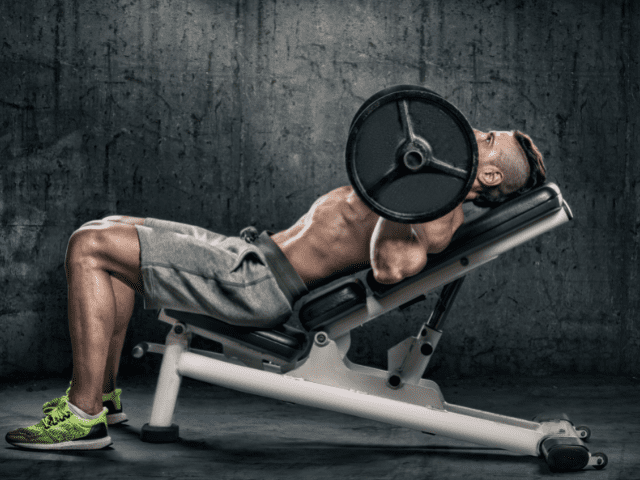
Don’t have dumbbells? My next suggestion would be to grab a barbell and do Incline Bench instead. (Yes, you can also do regular flat Bench Press as well, but my guess is you’re already doing that)
Equipment Needed
- Multi-purpose lifting rack
- Bench
- Barbell
- Bumper or Iron plates
Step-by-Step Instructions
- Determine the angle for your incline bench. Most programs would refer to a 45-degree angle as ideal for it provides the best chest and shoulder engagement.
- As you go higher with your angle, you are moving more toward a shoulder press. The flatter the bench gets, you are moving more toward a regular bench press.
- Set the height of the barbell so that when you unrack the barbell, you are only doing a very short upward concentric movement.
- Lie flat on your back on the bench.
- Keep your feet flat on the floor.
- Pull your shoulder blades together and keep the back of your head on the bench. You will slightly arch your back. Keep your core tight and keep the shoulder blades pulled back tight.
- Take a thumbs-width grip from the knurling and completely close your grip. Keep your knuckles pointing toward the ceiling and squeeze the barbell.
- Unrack the weight and take a deep breath.
- Control the barbell down during the eccentric movement and draw the barbell in, keeping the elbows at about a 45-degree angle away from the torso.
- The barbell will make contact with your torso right at the nipple line on the chest.
- Once contact is made, drive the barbell back up to the starting position.
Coaching Points
Do not let the elbows flare out away from the midline. The shoulders are incredibly vulnerable in these positions and the sheer force placed on the shoulders will lead to injury if the technique is not made a priority.
Dumbbell Bench Press
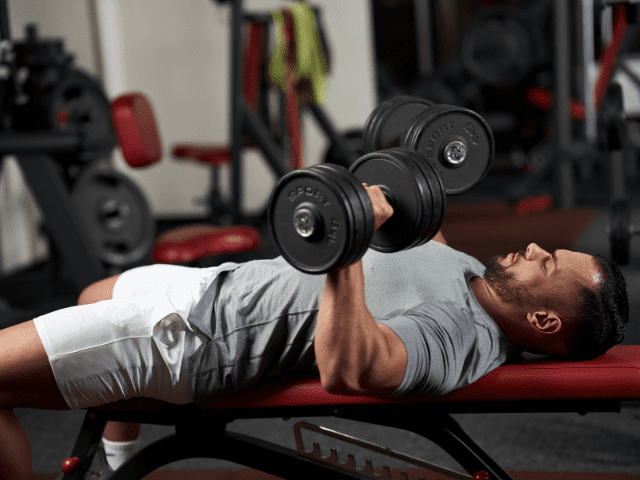
Dumbbell Bench Press is another solid pressing movement that does a great job of developing the chest muscles.
Equipment Needed
- Dumbbells
- Bench
Step-by-Step Instruction
- Grab your dumbbells, sit on the edge of the bench, and sit the dumbbells on your thighs vertically.
- Take a deep breath, lie flat on your back on the bench, and get your dumbbells in position ready to press.
- Keep your feet flat on the floor.
- Keep your butt on the bench.
- Pull your shoulder blades together and keep the back of your head on the bench. You will slightly arch your back. Keep your core tight and keep the shoulder blades pulled back tight.
- The dumbbells should be slightly angled (representative of the path you are descending with your elbows).
- Press the dumbbells up.
- Control the dumbbells down during the eccentric movement and draw the dumbbells in, keeping the elbows at about a 45-degree angle away from the torso.
- The dumbbells will make contact with your torso right at the nipple line on the chest.
- Once contact is made, drive the dumbbells back up.
Coaching Points
When your set is done, do not freely drop the dumbbells without checking your surroundings. You could drop the dumbbell and it might hit a person nearby. Or your could drop your dumbbell and crush your fingers on a dumbbell that was left next to your bench.
The best way to finish a set of Dumbbell Bench Press is to bring the dumbbells back to your thighs and stand up with them. Or have a lifting partner take them from you.
Feet Elevated Push-ups
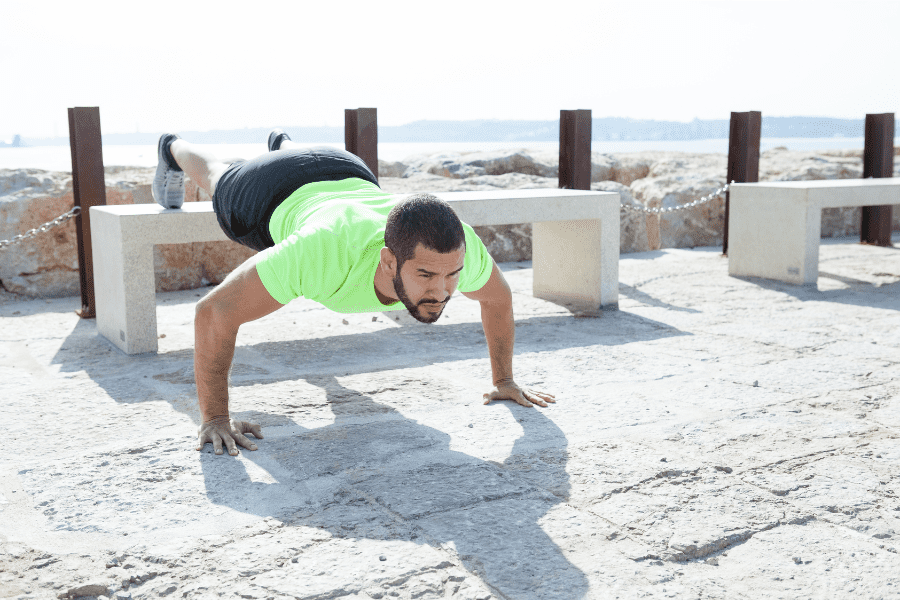
Short on equipment? Give Feet Elevated Push-ups a try.
And, honestly, they don’t even have to be Feet Elevated Push-ups. Push-ups are an exercise that often gets overlooked because they’re “too simple”. Truth is, most people would benefit TREMENDOUSLY by simply adding more Push-ups into their chest workout.
Equipment Needed:
- Bench or Box
Step-by-Step Instruction
- Lie face down on the floor and place your feet up on a bench or box.
- Pull your toes in so that you’re on the tip of your shoes.
- Eyes should be focused straight down or slightly up.
- Pull your hands close to about the nipple line of the chest and bring them out about 2-3 inches away.
- Take a deep breath, engage the core and brace.
- Push yourself up in one unit. There should be no sagging of the waist. The entire body from head to toe should move up and then back down in unison.
- Feel your scapula upwardly rotate and make sure the antagonist muscles (Back and biceps) are fully engaging.
- Lock out your push-up and pause.
- Slowly lower yourself back down and get ready for the next repetition from just above the ground.
Coaching Points
Take your time and master the push-up. The benefits of doing sound push-ups will pay dividends for your shoulder health and the potential to maximize your upper body strength.
Keep the elbows at a 45-degree angle. For maximal chest, shoulder, and rotator cuff engagement, do not let the elbows flare out away from the middle. Also, do not let the elbow hug right next to the torso.
Landmine Press
If you have a landmine, Landmine Presses are an excellent exercise both as an alternate pressing movement and a unique exercise to add some variety.
Equipment Needed
- Landmine Attachment
- Barbell
- Weight Plates
How To
- Set up a landmine attachment with a barbell.
- Grab the end of the barbell and start with it at chest level.
- Feet should be shoulder-width apart with knees slightly bent and core braced.
- Remove one hand from the bar and then press the bar to full extension with the other arm.
- Lower the bar back to chest level under control.
- Repeat until all reps are completed and then switch to the opposite arm.
Coaching Points
Keep the core braced and maintain a neutral torso. If you find yourself leaning back and arching the low back, lower the weight if needed and correct your form.
If you don’t have a landmine attachment, don’t worry! Here is how you can make your own DIY Landmine Attachment with just a tennis ball.
Dips

One of my all-time favorite exercises for developing the chest and triceps is Dips.
Equipment Needed
- Squat Rack
- Dip Attachment
- A Dip Station can be used as well if you have access to one.
Muscles Worked
- Chest
- Shoulders (Anterior Delt)
- Triceps
Step By Step Instructions
- Attach your dip rack to your rack. This process will vary based on your rack and dip attachment. Follow the manufacturer’s instructions closely.
- Set your dip rack just above waist height. This will allow enough room for your feet not to hit the ground while doing reps, but not so high you feel you have to jump up into your first rep.
- Starting position is hands on bars, arms extended, knees slightly bent and feet crossed (crossing feet is optional but does help with unwanted swinging in my experience.
- Descend down by bending the elbows and slightly leaning forward.
- Lower yourself under control until the triceps become parallel with the ground and then drive yourself back up to the starting position.
- Repeat until all reps are completed.
Coaching Points
The biggest mistake I see with dips is a poor range of motion. If someone is struggling to be able to do reps, the easiest solution is to simply not lower yourself into a full rep, but this is incorrect. If a lifter cannot perform a full rep they should switch to one of the variations listed below.
Medicine Ball Chest Pass
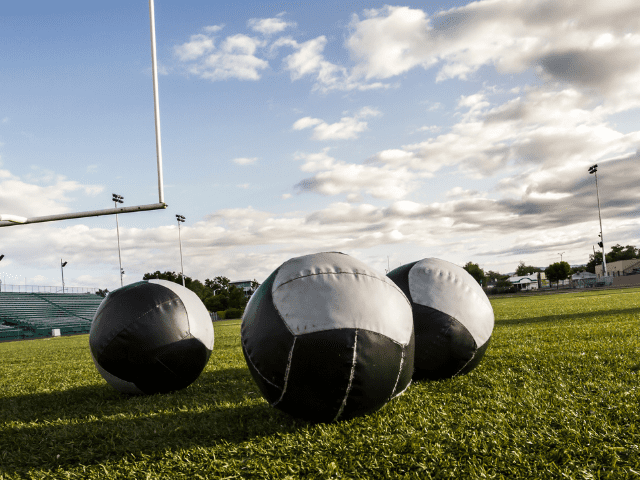
Medicine Ball Chest Pass is an explosive upper body exercise that can be done with a partner or a solid wall.
Equipment Needed
- Medicine Ball
- Partner or Solid Wall
How To
- Grab a medicine ball and a partner (or a solid wall)
- Start on your knees, sit back onto your calves and hold the ball at your chest.
- Explosively drive forward with the hips and throw the ball forward to your partner.
- The forward hip extension should cause you to fall forward.
- Catch yourself with your hands and then explosively push yourself back up to your starting position.
Coaching Points
Med Ball Chest Passes can be done from the knees as described above, but can also be done from a standing position. Regardless of what starting position you use, brace the core and be explosive!
Dumbbell Pullover
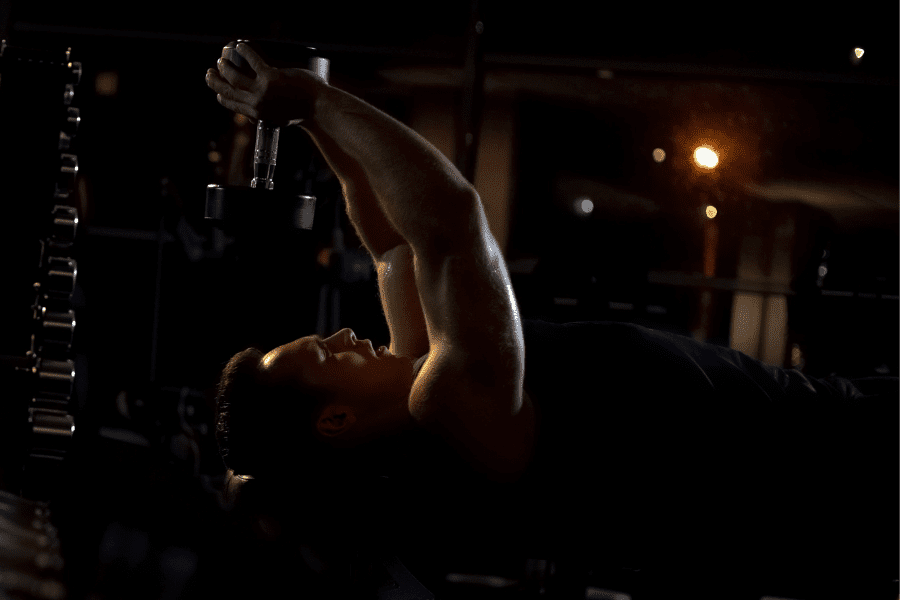
Dumbbell Pullovers are often thought of as an exercise for the lats or the serratus anterior, but Pullovers also hit the chest muscles really well. You also get a similar deep stretch like you get with Cable Crossover.
Equipment Needed
- Dumbbell
- Bench
How To
- Lay on a bench with the top of your head all the way to the edge of the bench.
- Make a diamond shape with your hands and place them on the inside of one of the heads of the dumbbell.
- Press the dumbbell to arm’s length straight up over the chest.
- Now, reach the dumbbell overhead (allow some bend in the elbow) until your hands are about even with the height of the bench.
- Finally, pull the dumbbell back to the starting position.
Coaching Points
Dumbbell Pullover will give a deep stretch to the chest and triceps on the lift’s eccentric (lowering) phase. Stay slow and controlled and focus on the stretch followed by the strong contraction as you raise the dumbbell back to the start.
Plate Loaded Incline Bench
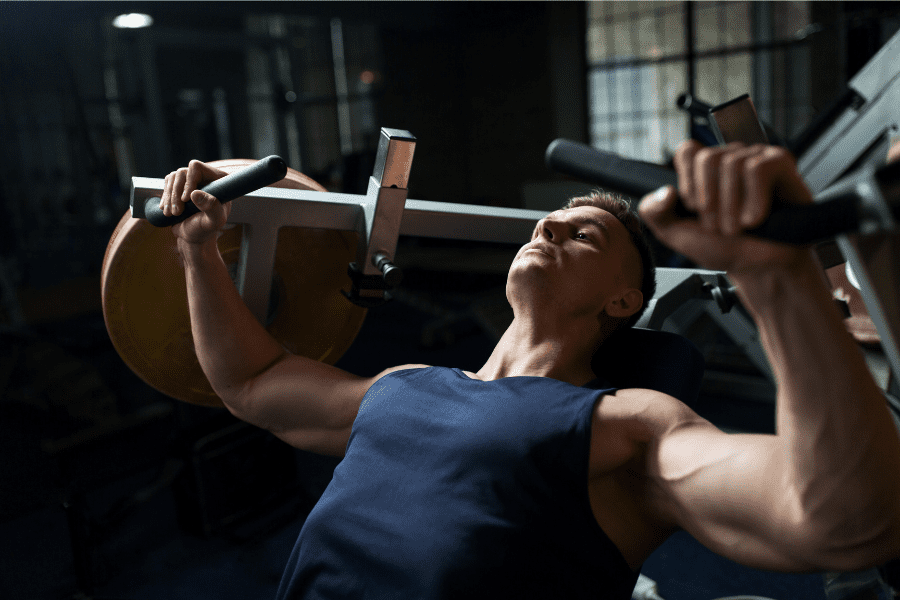
One of my final recommendations for a Dumbbell Incline Fly alternative is Plate Loaded Incline Bench. Most college weight rooms and big commercial weight rooms will have plate-loaded equipment from Hammer Strength or a similar company.
If you have access to one of these isolateral machines, they can be a great substitution for Dumbbell Incline Bench.
Pec Deck Flys
Finally, the last exercise on the list of Cable Crossover alternatives is another machine – Pec Deck Flys.
Unpopular Opinion – I’m not a huge fan of Pec Deck Flys. Never have been.
However, there is a reason why the Pec Deck Machine is one of the most popular machines in any gym. If you enjoy a good Pec Deck Fly, then by all means, they can make a great alternative for Cable Crossovers.
Final Thoughts
Cable Crossovers are a great supplementary exercise at the end of a good chest workout, but sometimes Cable Crossovers just aren’t an option. You may not have a cable crossover machine available to you or at other times you might just be looking to add some variety to your training program.
In these situations, you’ll need a Cable Crossover alternative and I hope that at least one of the alternative exercises I’ve listed here fits what you were looking for.

